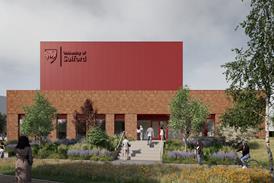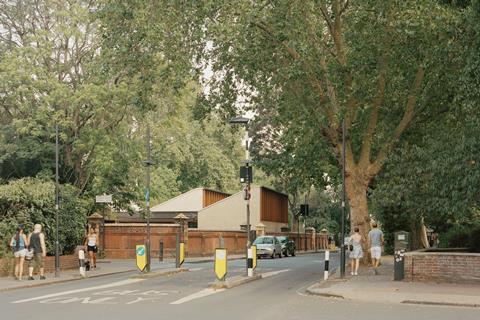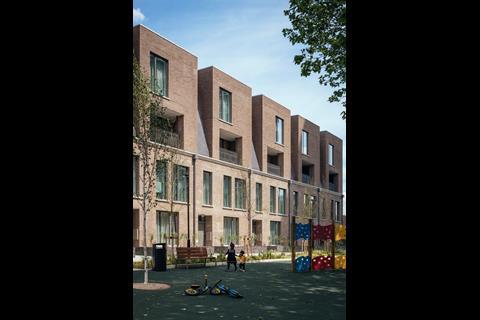The founder of the Stirling Prize-winning Mae Architects shares his influences and inspirations with Ben Flatman and concludes that his profession still has much to offer

Few contemporary British architects have managed to mix critical acclaim with wide-ranging impact on the built environment as effectively as Alex Ely. Mae, the practice that he founded in 2001, is recognised as an industry leader in housing, having not only designed numerous projects, but also written the hugely influential London Housing Design Guide 2010 for the Mayor of London.
And, last November, his practice’s widely praised John Morden Centre won RIBA’s Stirling Prize for best new UK building, confirming Ely’s status as one of the leading British practitioners of his generation.
BD recently caught up with Ely in Marylebone, in the heart of the Church Street Masterplan area. It is a part of London with which he has been closely involved for more than a decade and where Mae has just completed Daventry House, a sector-leading community supported-living scheme for Westminster City Council, consisting of 60 flats for those in later life.

“It feels like an age,” he says of the 23 years since establishing Mae, “and I guess it is.” Professorial in his bearing, Ely brings years of experience in public policy, education and private practice to bear on a wide range of issues, from the demise of CABE to the role of architects in public life.
The Stirling Prize
It is clear that, while winning the Stirling came as welcome recognition for those long years of hard work and commitment, there is no indication that Ely regards the prize as an end point in itself. Rather, he hopes to use the moment to move the practice in new directions.
“We’ve obviously built a reputation for housing and it’s still very much our principal focus,” he says. “We’re seen as a practice that can deliver high-quality public housing but are also part of a thought leadership group on the subject, and hence our work in policy development and drafting the mayor’s housing guide.
“But I think the thing about the Stirling win for the John Morden Centre and commissions like Sands End Arts and Community Centre [itself shortlisted for the Stirling in 2022] is that they really highlight our strengths as a practice in other sectors.
“The industry tends to pigeonhole architects, so I would really love the recognition of the Stirling to be a launch-pad for us into larger, more civic and social projects,” says Ely, before conceding that “the trouble is there isn’t too much of that being commissioned at the moment.”
Education and influences
He began his architectural education at the University of Nottingham in the early 1990s, before moving to the Royal College of Art (RCA) in 1995. It was soon after Nigel Coates arrived as head of school and was busy shaking things up. “He brought a huge amount of energy and ideas to the college, as well as brilliant new staff,” Ely says of Coates’s impact.
“It was quite a loose-fit structure,” he adds, explaining how the students were given significant leeway, including the freedom to bring in preferred architects and teachers – such as Tony Fretton – on their own initiative. “It didn’t follow the model of other schools that had a unit system where you very much have to align with a particular school of thought, led by the tutor.
“The school’s strength was in providing the framework and the provocations,” he says. “It gave you the courage to develop your own interests, while still having access to this highly intellectual, very talented group of tutors.”
The open-minded and non-dogmatic approach has clearly been hugely influential on Ely’s outlook. Mae’s architectural aesthetic evolves, while remaining rooted in key principles.
“There are foundations to our thinking as a practice, which are all the conditions. It’s not an object-focused architecture we create, it’s based on observation about where we’re working– the context, the city around us.
“It’s based on the sort of experience that you have as you arrive at a building or journey through it, or dwell and occupy it. So, I’m much more interested in the sort of conditions that architecture creates, and how you create positive spaces.
“I’m also still hugely influenced by modernism and its social values. And its very clear intentions to create a more democratic, more inclusive and almost sort of idealistic environment,” he explains. “But I’m also wary of it because it has failed in so many regards, especially in urbanism.
“And, again, there’s probably something that Nigel Coates pointed me towards – he was always a professor who thought carefully about the city around him and the architect’s role, which is partly what led me to work for CABE.”
CABE and the future of urbanism
After the RCA, Ely worked for the respected practitioner and teacher Pierre d’Avoine, where he completed his Part 3. He then decided to set up on his own.
“I started my practice pretty soon after college, rather naively and stupidly, but realised fairly quickly that I didn’t really know where things were going. So, I went to work for CABE as a policy advisor, just as it was being set up in those early days and it just completely opened my mind to the much broader influence that architects can have, the broader role of architecture in society.
“It was a really brilliant crowd, with Joanna Averley [chief planner at the DLUHC], Selina Mason [strategic design lead, Lendlease], Sarah Allan [head of architecture at the DLUHC], Jon Rouse [city director for Stoke-on-Trent], Mairi Johnson [director of major projects at National Museums Liverpool] and Peter Stewart [director at the Townscape Consultancy]. I had an amazing time there.”
Although Ely had already departed before the coalition government effectively disbanded CABE in 2011, he regards the decision as “tragic”.
“I think CABE was having such a strong positive impact and it still resonates. It leaves a legacy of design review, so that’s a positive. But I was very sorry that it disappeared.”
CABE was partly born out of Richard Roger’s report, Towards an Urban Renaissance, and, to many, was one of the most positive contributions that the New Labour era made towards the built environment. Is Labour doing the thinking now in advance of a possible election victory to ensure it hits the ground running on urbanism?

The rise and fall of CABE
The Commission for Architecture and the Built Environment was an executive non-departmental public body of the UK government. It was established in August 1999, evolving from the Urban Task Force chaired by Richard Rogers and the influential report, Towards an Urban Renaissance.
CABE inherited some functions from the discontinued Royal Fine Art Commission and assumed additional responsibilities as the government’s advisor on architecture, urban design and public space in England. Its primary role was to influence and inspire decision-makers in the built environment.
CABE advocated for well-designed buildings, spaces and places, conducted public campaigns and offered expert advice by collaborating directly with architects, planners, designers and clients.
In 2010, the coalition government decided to merge CABE into the Design Council as part of its “bonfire of the quangos”. The merger officially took effect on 1 April, 2011.
“That’s a really interesting question. I haven’t seen the detail behind it to know whether their proposed new towns programme and ideas around the ‘greybelt’ are born out of a similar vision as Towards an Urban Renaissance.
“But it doesn’t mean that the thinking isn’t happening in the background. You know, housing solution needs a lot of depth to it, which you can’t get across in a political soundbite. I suppose the politicians always have to find a shorthand to describe problems, don’t they?”
Does some of the lack of clarity on these issues reflect the absence of an influential architect or planner, such as Rogers, within the Labour hierarchy?
“Well, Richard Rogers was openly Labour, and he was a big public figure as well, able to articulate these priorities within government. He was quite unique and had amazing traction and a very willing audience.
“It’s hard when you’re in the profession to be able to know how it’s perceived from outside, or whether people currently recognise certain spokespeople for the industry. But Rogers’ ideas still stand – there’s a lot in the Towards an Urban Renaissance report that could influence any new town’s programme.”
Is there anyone to fill the gap now? “I don’t know. Maybe there is a place for a think tank or a sort of political party to commission some genuine new work on urbanism that helps the country to try and visualise their brief. I think architects have a lot to offer in that regard.”
The belief that architects have a public role that extends far beyond servicing developers is a central part of Ely’s philosophy. “Architects are quite holistic thinkers,” he says. “We’re able to problem solve and we we’re used to working with a huge range of disciplines.
“We were shortlisted a few years back by the National Infrastructure Commission to come up with placemaking proposals for the Oxford to Cambridge corridor and we came up with a proposition for a new town in a place called Calvert, which was the intersection between HS2 and the Oxford-Cambridge Line, where arguably you’ve got the transport infrastructure.
“Although no station is proposed there, when you do the economic analysis of having a station and having a city there, the knock-on impact is enormous. So it’s a bit of a tragedy that it wasn’t considered, but I’m definitely interested in that bigger thinking of how do you create new settlements?

London Housing Design Guide
The guide was published in 2010 and is primarily targeted at housing developers, registered social landlords, architects and planning officers in London. Its central focus is on establishing minimum space standards and policies regarding aspects affecting the home environment, such as daylight and noise.
Organised around six key topics, the guide addresses shaping good places, emphasising the importance of well-designed houses in positively impacting the city’s overall form. It stresses the need for a variety of houses to cater to London’s diversity, highlights the significance of access into homes for environmental quality and safety, advocates for raising the minimum standards for dwelling space, and underscores the importance of light and privacy within homes.
Additionally, the guide addresses the impact of climate change, emphasising the necessity for homes to be designed to accommodate predicted warmer summers and wetter winters.
“I’ve always wanted to play a role in civil society, and that’s partly why I got involved in policy work at CABE. I am interested in the fact that architects have agency beyond what they design.
“Mae’s portfolio is actually quite small and it’s affecting very few lives, but actually writing something like the mayor’s housing design guide is affecting tens of thousands.
“And so I think it’s critical to remember that we architects have that skill too – the ability to engage in broader public debate.”
Between modernism and tradition
By the time Ely was studying architecture, the 80s style wars and architectural postmodernism were already arguably historical events. But their echoes still lived on.
“There was a time when the debate in architecture was just getting polarised between traditional and modern. And it’s just such a sort of naive and simplistic way of discussing architecture.
“There’s a really interesting space between those polar opposites, which I’m much more interested in. And arguably it is where most architects are at. In my generation, but also among the architects that I admire, there was a recognition of a whole kind of alternative modernism.”
Of his architectural influences, Ely says: “It’s certainly the likes of Alvar Aalto, Hans Scharoun and Hugo Häring or even Louis Kahn. They’re architects who have a close interest in materials and a sort of tactility of architecture, but who are also perhaps a bit looser in their ideas about form and morphology. And I think you see that in some of our work.”
Are there contemporary architects that he looks up to? “I always think it’s better to try and stand on the shoulders of giants and it’s easier to recognise who the giants are when they’ve passed. Although there are a lot living architects and tutors that I do admire, I think I don’t necessarily want to pigeonhole myself into a certain gang.”
Stepping back into practice
Although his practice had been operating in parallel with his work at CABE, and was being run by his old friend and business partner Michael Howe, Ely returned to full-time practice in 2005.
“When I stepped back into practice after CABE it opened my eyes to actually the whole issue of how public works are procured and the opportunities for architects to get involved in urban design.
“Michael and I were very much running it together, and then he stepped away. It was after leaving CABE that I could focus on really getting more involved in public housing and social projects.
“A lot of our first breaks were through collaboration – reaching out to friends of ours in the industry, like Proctor and Matthews, Feilden Clegg Bradley and Hawkins Brown. We were teaming up with them because they have the scale and the reputation that we didn’t have at the time.”

Alongside the housing work, Mae is also well established as an experienced masterplanning practice, leading on the urban design for the huge Meridian Water scheme in Enfield, which is delivering 10,000 homes.
“With masterplanning, you’re thinking much more strategically about what makes a good neighbourhood,” Ely notes. “As architects, we really care about creating socially inclusive places and spaces.
“We’re seeing increasingly more opportunities for masterplanning. We’re doing one in Manchester at the moment in Collyhurst, as well as estate regen schemes like Agar Grove, that we did jointly with Hawkins Brown.”
What guides the practice’s approach to masterplanning? “I had a particular set of reservations about modernist urbanism. And I guess it goes back to the modernist versus traditional conversation. How do you design new developments in a way that feels like the cities we love, that have typically evolved overtime.
“A lot of my thinking on urbanism is still influenced by my time at CABE. Most urban designers operating today tend towards more traditional ideas of streets and squares and variety and diversity. A lot of modernism was driven by ideas of separating out pedestrians from the car, and often ended up being within mono tenure estates.”
How has this been reflected in Mae’s work? “One of our earliest projects was a retrofit of the Hillington Square estate in Kings Lynn. And it was a 1960s estate with gallery access and the ground floor was entirely garages, so it just had killed the street level. But through retrofit and the introduction of new stair and lift cores, we were able to give each block its own address.
“We converted ground-floor garages into part of the residential dwelling behind, so suddenly you could activate the street.
“And that project also highlighted something really interesting – how some of the qualities of modernism, such as the Parker Morris Standards, can be very generous. Also, the nice typologies that they explored and some of the social ambitions could remain while reimagining how they fitted into its wider context to create a place you could comfortably navigate through and dwell in at ground level.
“I suppose we see some of our work as being a bit of a marriage of modernist ideas and more traditional thinking. So, with our project at Agar Grove, for example, we were obsessed by the split-level typologies that were being developed during Sydney Cook’s time at Camden by the likes of Neve Brown and Benson and Forsyth.
“So, in our proposal, we’ve got split-level living, we’ve got triplexes, we’ve got duplexes, all interestingly interlocked and stacked. But, in terms of its urbanism, it is following quite a traditional kind of streetscape layout, with active ground floors and enclosed gardens, alongside shared gardens.”
The future
As Ely prepares to leave, he muses again on the Stirling Prize and its role in the wider industry. “The Stirling is a huge honour. It’s an absolute privilege to be among that company and have a project that hopefully offers some ideas for how to address today’s challenges.

“I think that’s part of the goal of the Stirling Prize. It should be a model.
“I mean, the John Morden Centre is quite a unique building in a unique setting, dealing with unique constraints, but actually it is a model of the sort of social infrastructure we should be doing more of for that part of society. So I very much hope it will have a positive influence.
“I think part of that will be down to us to keep talking about it and promoting it and its ideas in terms of its influence for the practice. It will be for us to try and push ourselves in front of certain opportunities.
“But the Stirling Prize’s reach is still limited, especially since it is not broadcast anymore. Which is a pity. Not because I’m wanting that sort of platform necessarily, but I think architecture deserves it.
“Architecture is so central to our culture and how we live that it is a pity it doesn’t seem to gain the traction or the platform it deserves.”
Given Ely’s adeptness at design and public policy, it rather feels that industry and politicans should be looking more to practitioners of his ilk. Then they might just provide the country with the built environment leadership it so desperately needs.




























No comments yet